Liege Style Belgian Waffle
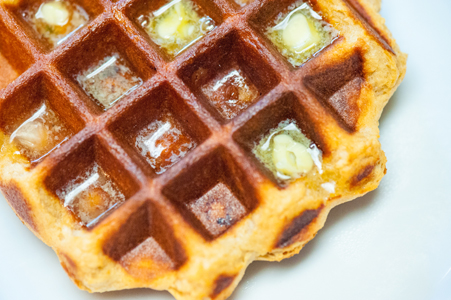 What is a Liege Style Belgian Waffle?
What is a Liege Style Belgian Waffle?
Waffles are defined by Wikipedia as “A waffle is a dish made from leavened batter or dough that is cooked between two plates that are patterned to give a characteristic size, shape, and surface impression.” There are several different styles of waffles served across the globe. The Buttermilk Waffle, the Brussels (or generic Belgian) Waffle, and the Liege Style Belgian Waffle.
The US has adapted to the chemically leavened batter variety of waffles, as known as the Buttermilk Waffle or generic breakfast waffle. This style of waffle uses the acid found in buttermilk, to activate with baking soda, and baking powder causing them to rise as they cook in the hot waffle iron. The batter expands and fills in the grid-like shapes of the iron, creating more surface area to brown and caramelize the flour’s starch. The results create crisp cups, perfect for holding melted butter and warm maple syrup. This batter method is quick to make, usually having the eggs separated, so that the whites can be whipped to hold onto the surrounding air (resulting in a lighter, more airy finished textured waffle), then folded into a batter of yolks mixed with buttermilk, melted butter (or oil) and maybe some vanilla extract. This is then stirred into dry ingredients (flour blended with baking soda, baking powder, salt, and a touch of sugar). These waffles use a very similar batter style to a buttermilk pancake recipe and have been used sometimes interchangeably. This variety of waffle is usually served with Fried Chicken (try my ‘Shake and Bake’ Hopped Fried Chicken), to make the Southern classic, ‘Chicken & Waffles”.
Meanwhile in Belgium, waffles are street food classics, served from little booths, stalls, and now food cart | trucks, in many of its picturesque cities. The smell of these Belgian Waffles is so intoxicating, so distinctive, that like Pavlov’s dog, the tourists | locals start to drool when the aroma fills their noses… This style of waffle is completely different from the US counterpart. The dough has flavor, it has fermentation-derived complexity, its texture is denser, with more chew, while still being tender and toothsome. This led me to want to understand what makes a Liege Style Belgian Waffle so amazingly delicious. I have had so many experiences consuming these Belgian gastronomy indulgences, that it is now a food memory, stuck in my head, that I can go back in time and reference. Pulling from this research and travel, I want to share with you how I came up with this recipe version and the technique to incorporate the ingredients correctly.
To clarify, not all Belgian Waffles are the same. There is another style of Belgian Waffle that is important to mention. The similarities between the Brussels Waffle and a Liege Style Belgian Waffle are that they both use yeast as a leavening medium. No baking powder or soda is used in this yeasted waffle. That’s about the end of the Belgian Waffle similarities. They both are crisp, deep ridges, and valleys to fill with toppings, syrups, and such. The Brussels style is simpler in flavor, there isn’t a large portion of butter, nor is the dough made with the steps mentioned below. Nuggets of pearl sugar aren’t used either, finding a more common appearance to that of an American Style Buttermilk Waffle. The Brussels waffle is also lighter in texture than its counterpart. My other Belgian Beer Waffle recipe takes the batter of a Brussels Style Waffle and adds pearl sugar, making a hybrid of the two styles.
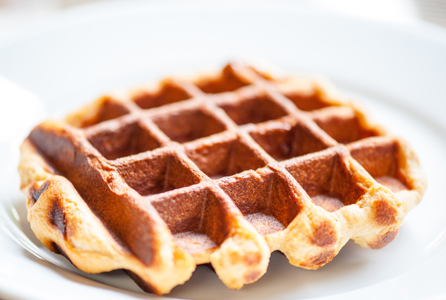 A true Liege Style Belgian Waffle is a truly unique culinary experience. With a history dating back over 600 years ago, this ‘street food’ has evolved over the decades and centuries. Due to its hand | snack-size portion and portability, almost like a Belgian style donut (Belgian Olibollen), yet eaten for breakfast, brunch, and | or an afternoon snack. This waffle’s characteristics are denser, heavier, with a sweeter finish than its northern Belgian cousin. The waffle mixture is a dough, not a batter. The formation of an enriched dough sets this Liege waffle apart. Sweet pockets of special pearl sugar melt and caramelize into crunchy candy pieces. The high heat comes from two sides, sandwiched between hot grid-patterned plates, transforming the dough into a baked pastry of sorts. Vanilla, caramel, toffee all waft into the air, as the yeast has created a platform for the wonderful and intoxicating aroma to be released. The finished irregular-shaped waffle is distinctive, blond to a golden brown, with a beautiful structure on the inside, making them the perfect scrumptious treat.
A true Liege Style Belgian Waffle is a truly unique culinary experience. With a history dating back over 600 years ago, this ‘street food’ has evolved over the decades and centuries. Due to its hand | snack-size portion and portability, almost like a Belgian style donut (Belgian Olibollen), yet eaten for breakfast, brunch, and | or an afternoon snack. This waffle’s characteristics are denser, heavier, with a sweeter finish than its northern Belgian cousin. The waffle mixture is a dough, not a batter. The formation of an enriched dough sets this Liege waffle apart. Sweet pockets of special pearl sugar melt and caramelize into crunchy candy pieces. The high heat comes from two sides, sandwiched between hot grid-patterned plates, transforming the dough into a baked pastry of sorts. Vanilla, caramel, toffee all waft into the air, as the yeast has created a platform for the wonderful and intoxicating aroma to be released. The finished irregular-shaped waffle is distinctive, blond to a golden brown, with a beautiful structure on the inside, making them the perfect scrumptious treat.
What is an Enriched Dough?
In my waffle research, both in tasting from stands on the streets of Bruges, Antwerp, Ghent, and Brussels, along with many special Belgian-inspired dinners, I have developed a love for this style of waffle, the Liege Belgian Waffle. Freshly made and served hot, this style of waffle is rich, ultra buttery, crisp on the outside while tender on the inside, with golden brown divots, set in a grid, that increase the cooking surface of the waffle, giving it, well its name. There are sweet pockets of a toffee | caramel | candy crunch unevenly dispersed throughout the flavorful waffle, created by the addition of pearl sugar crystals. Due to the fermentation time and extra steps borrowed from the French baker, in the form of a Brioche bread, this waffle dough is very different from other types of waffles. Brioche bread dough contains a lot more fat, from both egg yolks and butter, lots of delicious butter.
An electric mixer is the easiest way to make an enriched dough. These are the steps to create an enriched style of bread dough:
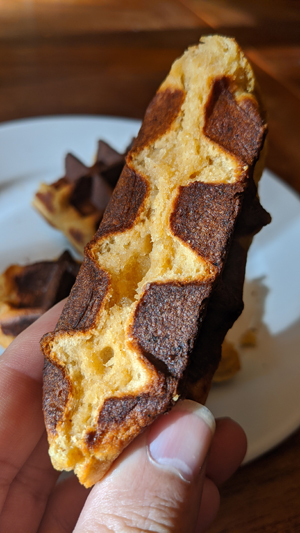 A sponge is formed; creating the beginning of the gluten development from the flour’s starch while hydrating the flour and also feeding the yeast the first wake-up meal. This step gives the dough more fermentation time, making it more digestible, creating more flavor compounds, and helping with the finished browning | crust formation. This dough is very moist, sticky and this step adds about 30 minutes to the final dough’s preparation.
A sponge is formed; creating the beginning of the gluten development from the flour’s starch while hydrating the flour and also feeding the yeast the first wake-up meal. This step gives the dough more fermentation time, making it more digestible, creating more flavor compounds, and helping with the finished browning | crust formation. This dough is very moist, sticky and this step adds about 30 minutes to the final dough’s preparation.
Next, eggs are added, bring extra fat from the yolks into the dough. More flour is added and the dough is formed, kneaded to create more gluten strains, and then “IT” is added. The ‘it’ being butter, room temperature butter. As butter is fat, I go ‘for the gold’ and use the best butter I can get my hands on. Straus Family Creamery makes a European Style Unsalted Butter that has a higher percentage of butterfat than just standard unsalted butter. The cultured butter is richer in taste, a result of more fat and less water in the final butter. To be called butter in America, the butterfat content needs to be at least 80%. European style butter ranges from 82-86% butterfat. If you can’t find Straus, an excellent alternative, that will make these waffles more ‘authentic is using unsalted Chimay Butter from Belgium. This room temperature butter is emulsified into the dough, slowly, tablespoon by tablespoon. As the electric mixer fitted with a dough hook works in the butter, the final result is a bread dough with more fat than any sourdough or other type of bread dough. The resulting texture and crumb of the bread are tender, pulling apart easily. The dough is then left for 15 minutes, to relax, then mixed again, to further develop the gluten in the dough.
At this point, I turn out the dough, weigh it and then divide it into serving size portions. This recipe yields 1220 grams of dough. Dividing the dough into 152-gram portions makes a perfect size waffle. Using sandwich bags, I form the dough into balls, then place them into the bags, then seal them. Place these bags into the refrigerator for at least 24 hours and up to 120 hours (or 5 days), to slowly ferment. With a refrigerator being typically set to 38°F | 3°C, the slow fermentation allows the yeast to enjoy their meal, creating lovely flavor compounds to the finished waffle. These steps set this waffle apart from a buttermilk waffle, in almost every way possible. Plus, these waffles are more digestible due to the slow fermentation of the yeast.
My Liege Style Belgian Waffle dough is more similar to a Brioche dough than a standard dough, as I further increase the fat content with extra eggs than a Brioche recipe would call for. I also add in Greek yogurt (more cultures) with the warmed milk, and the use of European style butter all combine to make a very special dough.
For flour, you could use all-purpose flour. I use a combination of flours, to add some extra texture, flavor, and nutrition. Einkorn is an ancient grain that adds an almost nutty element to the waffle. This flour is available from Central Milling. I love using their flours, as they are also freshly milled, have a wonderful texture and the results in your baked goods will be noticed.
To add an extra flavor element, similar to adding miso to a recipe, I sneak in some Malted Milk Powder to give that extra pop of wow, when these waffles are cooked.
Types of Yeast:
As these waffles are fermented and use yeast, I wanted to help share with you the different types of yeast products a consumer can find | buy | trade.
Dried Yeast:
Active Dry Yeast is the most common ‘baker’s yeast’ available in most grocery stores. This product removes the water from the live yeast, then grinds up the yeast into granules and packaged.
Instant Yeast or sometimes called bread machine yeast is created similarly to Active Dry Yeast is, yet the granules are smaller, so it can dissolve easier into the dough. It is said that the yeast strain for Instant Yeast is different from Active Dry Yeast.
RapidRise Yeast is another variety of dried yeast. Fleischmann is a very common grocery store brand. This yeast strain has been developed to create one single ‘proof’ vs other yeasts that require two or three risings. This type of yeast is great for a cinnamon roll, something without a lot of flavor from the yeast. This is not a good choice for pizza dough or this waffle recipe.
For reference, an envelope of dried yeast is equal to 2 1/4 teaspoons or 1/4 (.25) of an ounce.
Fresh Yeast:
Fresh Yeast, also called cake yeast or compressed yeast, found more in the commercial food | wholesale side of the baking world. This yeast comes in a small block | brick, doesn’t last very long, maybe a week in the walk-in. Professional bakers use this variety of yeast to make bread by crumbling it, adding warm liquid and flour to create a sponge. It does produce a nice, mostly neutral flavor in baked goods.
Beer Yeast, sold in a liquid or dried state, with tons of different varieties to choose from. I prefer using a Belgian style, such as a Trappist variety, that could even be from the bottom of a bottle-conditioned brew. The results I’ve had using Belgian yeast in pizza dough to bread is pretty cool and creates some unique flavors in the final baked goods. When using brewers yeast in baking, it is important to increase the fermentation time, as these yeast strains are more adept at consuming liquid sugars versus moist flour starch. Temperature is also important, to give the yeast a good environment to work in.
Sourdough Starter is a combination of wild yeasts and bacterias. Flour and water are mixed to create a very wet slurry, that is left to feed what yeast is in the air and what microorganisms are coating the flour grains before it is milled into flour. After about three to four days, the starter will come alive, then requiring regular feedings of more flour and water. As with each region around the world, microflora is unique to each area. Each sourdough starter is unique and acts differently, requiring some getting to know how to use it most efficiently. I learned from Nancy Silverston, in her amazing cookbook Breads from the La Brea Bakery to add wine grapes, wrapped in cheesecloth, to the flour-water slurry. The wild yeasts on the grapes help propagate in the starter, further adding flavor by the grape juice that ferments in the sourdough starter. If you make a sourdough starter, you will have lots of starters, with all the feedings required to keep it alive and healthy. Another tip I learned from Mike “The Bejkr” Zakowski: take some of your extra sourdough starters, place onto a piece of parchment paper, using an offset spatula, spread to create a thin layer. Let this air dry for a few days. Then peel off the yeast, grind it in a blender, and store in an airtight jar in the refrigerator for later use. This is a great backup for your sourdough starter, just in case anything happens to it. I use this dried sourdough starter in this recipe. While not essential, it does add to the flavor profile in the finished waffle.
Fermentation:
Once the yeast is added to the sponge, the dough begins its fermentation. This recipe can be made in about 3 hours, after the dough is made, by covering the mixing bowl with plastic wrap or a moist kitchen towel. Yet the results are not as delicious as a long slow fermentation. I’ll share a cool trick I learned from Peter Reinhart when making pizza dough. First, use all cold ingredients to slow down the fermentation process. Then portion out the dough into individual bags, placing the small dough balls into this sealed environment, preventing it from drying out and being able to ferment in the refrigerator easily. Using this same technique for waffles further makes having a delicious feast as easy as making a pizza. Place the bags into the bottom of your fridge and the next morning, or the morning after that, or each morning, pull a bag and let it sit on the counter for 20 minutes, to warm up slightly. This way, you can have fresh, hot, Liege Style Belgian Waffles for breakfast | brunch all week long.
I also add the pearl sugar to the waffle dough at this point. I roll out the dough slightly, to make a rectangle | oval-like log. I usually add enough pearl sugar to evenly cover the dough, then I wrap it up so that the sugar crystals aren’t exposed to the direct heat of a hot waffle iron, which can create burn spots on the finished waffle. This also helps keep your waffle iron clean, without having to be inspected between each waffle. More on this in the recipe directions below.
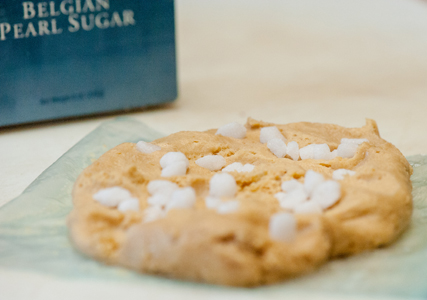 What is Pearl Sugar?
What is Pearl Sugar?
I’d mentioned above, this special ingredient called pearl sugar. But what is it? Essentially, pearl sugar is regular refined white table sugar (sucrose) that has been compressed to create larger sugar crystals. As the crystal structure builds from the small sugar granule, the resulting larger piece doesn’t melt at most baking temperatures. The result is a sugar that can be added to the top of a bread or pastry (think danish or other European style pastry), brushed with an Egg Wash to help them stick to the surface, and they will hold their shape and texture, giving the final baked product a crunch of sweetness. Belgian Pearl Sugar is a larger-sized sugar crystal, whereas Swedish Pearl Sugar (pärlsocker) is a much smaller-sized version. Sometimes Pearl Sugar is called Hail Sugar or nib sugar, linking its size and look to small ice crystals. All these sugar products are based on the same compressed sugar product. Belgian Pearl Sugar can be bought online and a good brand that I’ve had good luck with is Lars’s Own. It can sometimes be found in a gourmet or European-style grocery store. If you want to make sure you have enough Belgian Pearl Sugar on hand, it can also be purchased in large amounts: Belgian Pearl Sugar in Bulk.
Some websites make pearl sugar by taking white sugar cubes, placing them in a bag, and smashing them with a hammer. I tried this and the product is not the same, nor will the results be the same. I will try to make some homemade versions of Belgian Pearl Sugar and revise this recipe if I get worthy enough results.
Are there any substitutes for Belgian Pearl Sugar? La Perruche Pure Cane Rough Cut Cubes are probably the closest sugar product that I could find. They make a golden and a white rough cut sugar cube that is very different in texture to a standard sugar cube from C&H. Toffee pieces (think chocolate-coated Heath Toffee Bars found in Ben & Jerry’s Coffee Toffee Bar Crunch) are also different, as butter, sugar, and water are combined, heated to a hard crack stage, and then cooled. While not pearl sugar, one could make Beer Bark or Beer Brittle, break it up into small pieces, and use this as a sugar substitute for this style waffle recipe.
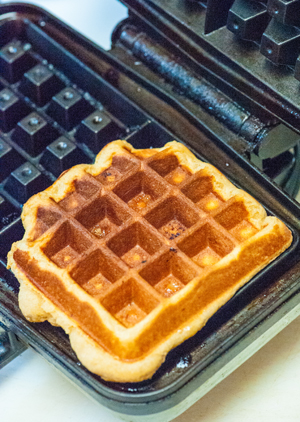 Special Equipment to Make Liege Style Belgian Waffle:
Special Equipment to Make Liege Style Belgian Waffle:
In order to make a good waffle, one must have a waffle iron. Here are a few that I recommend.
Waffle Irons
- The basic: Cuisinart Double Belgian Waffle Maker
- The advanced baker: All-Clad Stainless Steel Belgian Waffle Maker
- The professional baker: Commercial Nonstick Belgian Liege Waffle Maker
- And if you want to get fancy: Stainless Steel Waffle Fork
Kitchen Scale
As this recipe and many other recipes on Home Brew Chef are measured by weight, not volume, good quality and easy to use kitchen scale is recommended. I have and used this OXO Stainless Steel Food Scale for years. It’s accurate up to 11 pounds, does grams or ounces, and the pull-out display comes in handy when the bowl | pot | container would otherwise cover the readout.
How to Serve Liege Style Belgian Waffle:
These finished waffles are amazing, just as they are, hot, right out of the waffle iron. They can be slathered with room temperature butter, I prefer an unsalted European Style (having a higher butterfat content) butter, such as Straus Family Creamery. Letting the butter melt into the individual pockets, created by the hot iron, increasing the surface area of the waffle, making a crust, to hold that butter. Some dust their waffles with powdered sugar. I prefer my Malt Powdered Sugar. One could also use maple syrup, or an infused maple syrup, barrel-aged maple syrup, like ones by Blis Gourmet. I like using my Barley Malt Maple Syrup recipe. Or top them with homemade curds, like a Witbier Curd, or a beer jam (my favorite Rhubarb & Rodenbach Grand Cru Jam), Hopped Strawberries, Whipped Yogurt and | or a simple organic whipped cream, with no sugar or extra flavorings, to add the texture and silkiness with a pure, unadulterated finish.
Another way to prepare these Liege Style Belgian Waffle for a crowd is to pre-cook the waffles and either keep them warm in a 200°F | 93°C oven, placed right onto the oven racks (keeping them separated and not stacked upon themselves, so they don’t get soggy). Another option is to cook them 90% of the way, then set them on a wire rack. When your guests are hungry, place a waffle back into the hot iron and re-heating them for about 2 minutes, to finish the cooking. This same idea can be done, by freezing the 90% baked waffle in individual freezer bags and thaw them before re-warming in the hot waffle iron.
Another few variations of this Liege Style Belgian Waffle was used at a San Francisco Toronado Belgian Beer Dinner I did a few years ago. The waffle dough had the same composition, except I added a spice blend, that also has a Belgian culinary origin, Speculoos. Think cinnamon ginger-flavored cookie (Biscoff) and other complementary spices like cardamom, anise seed, white peppercorns, cloves, and nutmeg all rolled into one flavor wheel. The cooked Speculoos Waffle was then cooled and dipped | coated into a Belgian Quadrupel infused dark chocolate ganache for extra richness and complexity.
Liège Style Waffle
speculoos flavored yeast waffle made with Chimay Red, Belgian pearl sugar, dipped in a St. Bernardus Special Edition Abt 12. quad chocolate ganache
De Struise Brouwers Black Albert 2009
De Struise Brouwers Pannepot 2007
This was a different year, 2012 I believe:
Strawberries and Liege Waffles
pearl sugar studded brewer’s yeast waffles, organic strawberry rhubarb vanilla bean Westmalle Tripel jam, and a Dutch Advocaat sauce
Brouwerij Bosteels Tripel Karmeliet

| Servings | Prep Time |
| 8 waffles | 30 minutes |
| Cook Time | Passive Time |
| 5 minutes | 24 hours |
|
|

|
Liege Style Belgian Waffle recipe, using a few culinary tricks to re-create the delicious Belgian Street Food I love!
|
- 120 gram milk, whole preferably organic and not homogenized
- 90 gram yogurt, Greek Style, whole milk, plain, preferably organic
- 1 each egg, large at room temperature, Omega 3 rich, cage free
-
20 gram
sugar, coconut, Blonde such as Big Tree Farms Organic Coconut Sugar Blonde
- 7 gram yeast, dried such as Red Star instant
- 1 gram Sourdough Starter, dried see note above
-
140 gram
flour, all-purpose such as King Arthur Flour
- 133 gram Flour, einkorn
- 5 each egg, large at room temperature, Omega 3 rich, cage free, mixed
-
5 gram
salt, Pink Himalayan such as Pink Himalayan Salt
-
22 gram
sugar, coconut, Blonde such as Big Tree Farms Organic Coconut Sugar Blonde
- 36 gram sugar, organic
-
15 gram
Malted Milk Powder, such as Nestle Carnation Original Malted Milk
or powdered milk
-
125 gram
flour, all-purpose such as King Arthur Flour
- 8 ounce butter, unsalted at room temperature, European style, preferably organic, grass fed
-
40 gram
Belgian Pearl Sugar, available HERE
- To make the sponge, place the bowl of an electric mixer onto a scale. Tare or zero out the scale and add the whole milk, preferably warmed to 110°F | 43°C, then zero out the scale again. Next add the Greek-style yogurt, again tare the scale. Add egg, coconut sugar, dried yeast, sourdough starter (if using, if not see below in the Recipe Variations), all-purpose flour, and einkorn flour (or substitute all-purpose flour). Fit the electric mixer with a paddle attachment and on low speed, mix all the ingredients together until a wet dough is formed. Mix on low for about 5 minutes, then turn off the mixer and let the sponge sit for 30 minutes.
- After the sponge has set, turn on the mixer to medium speed for a minute. This will create more gluten, stretching the flour's starches.
- Add the eggs, salt, coconut sugar, sugar, malted milk powder, and all-purpose flour. Replace the paddle attachment for a dough hook, and on low speed, mix the dough ingredients together for about 5 minutes. The dough should form into a ball, be pulling away from the sides of the bowl, while still being sticky. Let the dough rest for 10 minutes.
- Have the butter near the mixer, cut into one tablespoon-size piece (8 tablespoons per 4 ounces of butter per 1 stick making a total of 16 tablespoons for both sticks). Turn the mixer on medium speed, then, with the motor running, toss a tablespoon of room temperature butter into the center of the dough, near the hook. Let the butter fully incorporate before adding the next tablespoon. Continue until all the butter is emulsified into the dough. Turn off the mixer and let the dough rest for 15 minutes.
- Turn the mixer on medium speed for about 5 minutes, then transfer the dough to a scale. Weigh the dough. It should weigh about 1220 grams. Divide the dough into 152-gram pieces, making 8 total. Knead each dough into a ball, repeat.
- Place each dough ball into a zip-top sandwich bag, seal, then place it into the coldest part of your refrigerator. Check the time and wait for 24 - 106 hours before continuing with the recipe.
- For best results, remove as many portions of waffle dough as you are going to cook. Let the dough rest on the counter for 30 minutes before cooking, allowing the dough to warm, waking up fermentation.
- Plugin your Belgian Waffle Iron and set the heat level to the lowest setting. Preheat the waffle iron for a good 10 minutes before cooking a waffle. Make sure the grids are clean and spray the iron with a non-stick spray before adding continuing. As the waffle dough is thicker than a pour in batter, the dough takes longer to cook. This takes more time at a lower temperature, ensuring a full bake, while not burning or over-browning of the waffle exterior.

- Take the waffle dough out of the bag. Set up on top of the plastic bag. Using your fingers, spread the soft dough out into a rectangle | oval shape. Make sure the dough is an even thickness.
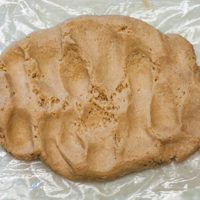
- Next, add the Belgian Pearl Sugar, I usually use about 5 grams per waffle. It's up to you, how sweet you want your waffle.
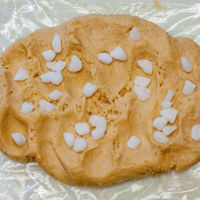
- Fold over one side of the dough, onto itself.
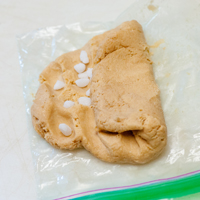
- Fold the opposite side onto itself.
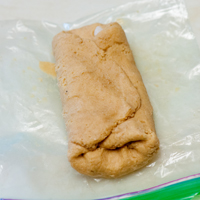
- Then fold over the two opposite sides to make an envelope, holding the Belgian Pearl Sugar in the center. This will help prevent the sugar from burning into the cracks | edges of the waffle iron, as the waffle cooks.
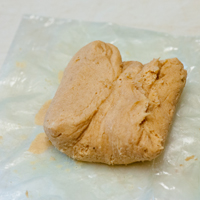
- Center the dough onto one side of the waffle maker. Depending on your model, cook one or two at a time. Close the lid and press the two irons together, until you hear the iron touch the Pearl Sugar.
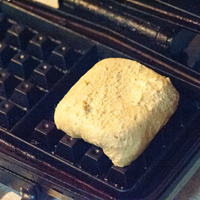
- Cook the waffle for about 4 - 5 minutes. The outside of the waffle should turn a beautiful golden hue, with the whole kitchen smelling amazing.
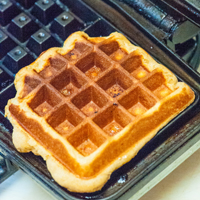
- Transfer the finished Liege Style Belgian Waffle to a plate and serve. Toppings are personal, but I would suggest having the first waffle plain or with butter... To truly experience this waffle.

- If you are making several waffles, to feed friends | family, have your oven preheated to 200°F | 93°C and place the finished waffle directly onto the oven racks, to prevent them from getting soggy and staying crisp.
- These waffles can also be par-cooked about 90% of the way through, then cooled on racks, wrapped | bagged and frozen for a later date to be consumed. Like the "Eg-O", pop the frozen, unwrapped waffle into a hot waffle iron to cook for about 3 minutes, heating it through and finishing that last 10% cooking. This results in a super quick breakfast treat!
Liege Style Belgian Waffle Recipe Variations:
- Sadly einkorn flour is not available in the grocery stores, use all-purpose or bread flour. I would suggest researching ancient grains like emmer, Kamut, different varieties of wheat, that are GMO-free, organic, and grown locally. Support your local mill, use freshly milled flour.
- If you don't have a sourdough starter, leave it out, add another gram of yeast.
- As anyone who has a sourdough starter knows, with feeding a starter, one has extra sourdough starter to use. This waffle recipe can be made with a 100% sourdough starter. Substitute the dried yeast for 8 grams of sourdough starter.
- Coconut sugar is lower on the glycemic index than table sugar. I love the flavor of this product over standard white sugar, as the caramel layers add a toffee | butterscotch element to the finished waffle.
- To mix it up, add minced Homemade Candied Orange Peel, with the pearl sugar, before baking. Or use the byproduct of making your own candied citrus peel, the syrup, over the waffles, or as a sweetener | flavoring to whipping cream | whipped yogurt.
More Waffle Recipes:
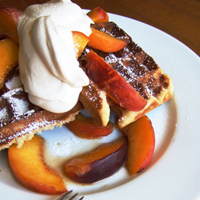
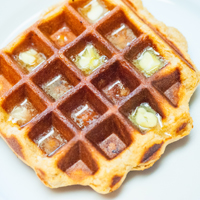
Pancake Recipes:
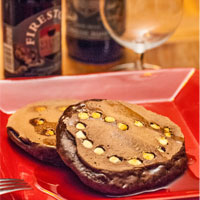


Beer Donut | Doughnut Recipes:
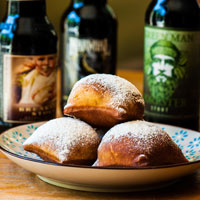


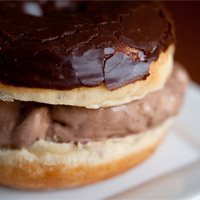
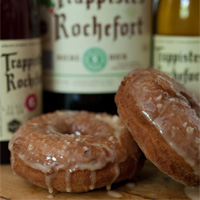
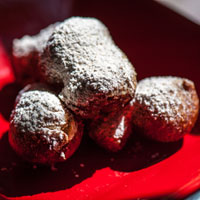




Great information given on this subject. Did you know of any company who produces the dough and pearl sugar? If so can you send their contact. Thanks
Hi Sam,
This dough recipe is different, as explained above, from other recipes of Belgian Waffles. There are other products you could buy, yet I don’t think that they will be as good as this recipe. The pearls are also available, see hyperlinks above.
Hope you try this recipe. Would love to hear your thoughts on it!
Cheers,
Sean
Did you make this with the dough recipe with the suggested measurements? with 5 eggs and only 125 g of flour, it is just liquid, so I ended up using 3x as much flour to get it to form a ball. Also, 4 oz of butter in America is 1 stick, 8oz is two sticks. Is it one stick of 8 oz of butter? I am so sad this recipe is not right given all the time and energy given to writing all the explanations about waffles in general. I am not sure if they will turn out or not, because the recipe is not correct. I measured everything exactly with my kitchen scale in grams and they are for sure not correct. Please fix the recipe ASAP. It is difficult to waste 5 eggs at .33 each and 4 or 8 oz butter which is also expensive if you use the good stuff. So sad in Germany!
Sherry
Hi Sherry,
I think you miss read the recipe. The first step is to make a sponge, using 140 grams of all-purpose flour, and 133 grams of einkorn flour, an ancient grain flour (or a total of 273 grams of all-purpose flour) with 1 egg, and the remaining ingredients for the sponge. After letting this sit to ferment, then the second addition of ingredients is added, along with the extra 5 eggs and 125 grams of all-purpose flour. As with brioche dough, the 2 sticks or 8 ounces of butter are added to the dough at the end, creating a very soft dough. So the final dough uses 398 grams of flour and 6 whole eggs and 8 ounces of butter, plus the other ingredients mentioned. As with any baked good, the procedure is critical, as are the measurements.
Hope this helps.
Sean
I think your ingredients have an error somewhere… Your ratio of wet to dry will result in a batter rather than a dough. I’m look at the metric list BTW, you might check that conversion is being done correctly if your starting point is US Imperial.
Hi Marcus,
Thanks for the question on ratios. The measurements are in grams, to be as specific | precise as possible. The liquid ingredients are minimal, as the yogurt and butter are in their solid form. I’ve made this recipe a few times, testing the ratios and they do work. I’d suggest trying the recipe as what I did and describe, then hear your thoughts.
Cheers,
Sean
I added more flour, but it is still too runny to use as a dough.
Please see my comment above. The flour should have been a total of 398 grams, to 6 total eggs. The sponge is a first fermentation, followed by a second addition of ingredients to create more flavor into these Belgian Waffles.